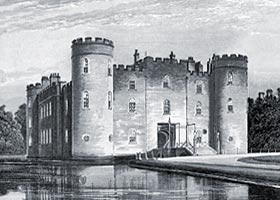The Tower of London - the most famous Square Keep (The White Tower)
William the Conqueror built the White Tower. It is the most famous Castle Keep in Great Britain and situated on north bank of the Thames River. Construction of this famous castle keep started in 1078. - The White Tower is 90 feet high
- The thickness of the walls ranged from 15 feet at the base to almost 11 feet in the upper storeys
- Above the battlements four turrets were built
- The name of the Norman Master Builder who built the square keep was Gundulf
- The White Tower was built by Norman masons but the labourers were English (Anglo-Saxon)
- The East and South sides of the White Tower were protected to the by the old Roman London City walls
- The entrance to the Tower is on the first floor accessed via a removable staircase, designed to make invasion of the White Tower more difficult
- The first structure on the site was a Motte and Bailey castle
- The White Tower was commissioned by William the Conqueror in 1078 and completed in 1097
- The North and West sides of the White Tower were protected by ditches
The Square Keep changes to a Round Keep!
The first type of castle keep was square. The square Castle Keep proved to problematical as it was subject to assault by mining. Tunnels were mined leading to a weak part of the stone castle (the corners of the square stone keep). The corners were also subject to blind spots - an attacker could take cover behind the corners. These defensive problems led to a change of architecture towards the end of the 12th century and the development of round stone castles and keeps began. The round castle keep afforded no screen to the enemy. The Shell Castle Keep
The shell castle keep was developed because the motte (mound) on which the castle was to be built could not bear the weight of a solid stone tower. This process was called 'Revetting the Motte'. The principle of 'Revetting the Motte' was to prevent the Motte collapsing under the heavy weight of a stone keep. The shell castle keep was created by building a stone wall which completely surrounded the upper part of the motte (mound), similar to the old palisades. These types of keeps were hollow and distributed the weight. The shell castle keep walls were strengthened by the addition of wall towers and buttresses. The walls of the Shell Castle Keep were between 8 and 10 feet thick and could range from 20 to 25 feet in height! This type of shell was not fragile! The shell keep walls were often strengthened even further by the addition of gatehouses, wall towers and buttresses. The wall acted as a defence during the re-building process. The Lord of the shell keep castle, and his family, were usually housed within the circular area enclosing the keep. The Castle Keep
The development of the Castle Keep was important as the most protected part of the castle. The square shaped stone castle keep is the dominant feature of many of the castles in England which were built by the Normans, and one of the most commonly recognised parts of a Castle - the information provided on this page charts the objective and development of the English castle keep. | 
